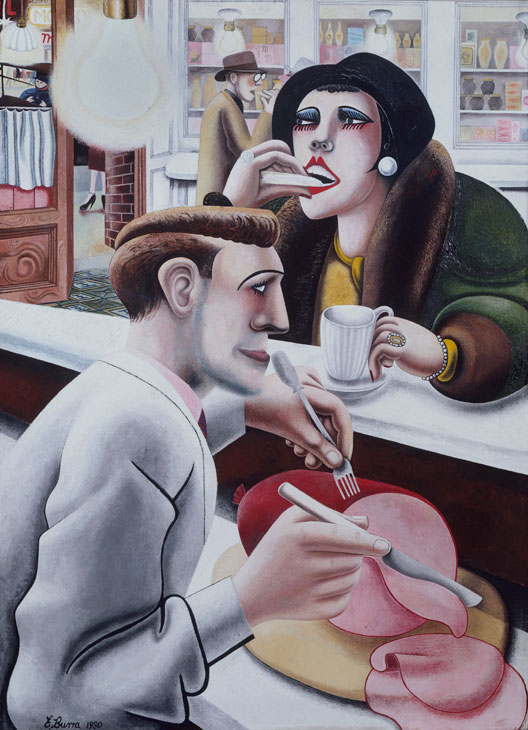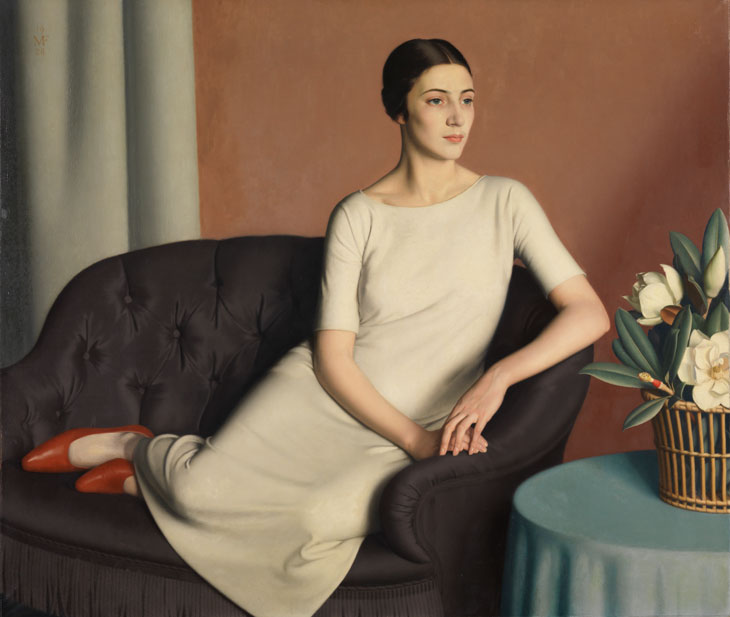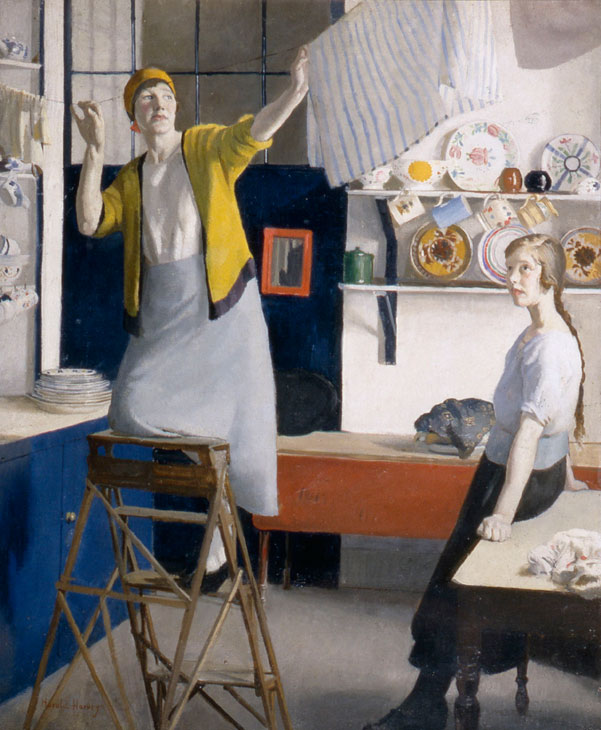One of the funnier subplots in the new exhibition of British realist painting from the 1920s and ’30s at the Scottish National Gallery of Modern Art is how slowly Edward Baird painted. The apples and pears in Still Life (1940) were a gift from his brother in the Merchant Navy, intended as a treat for family friends at a time when, thanks to the war, fruit was in short supply. Baird took them for his painting, but spent so long over it that they were rotten by the time he had finished: you can see the dusky blush of one apple’s skin starting to cave. Birth of Venus (1934) was started as a wedding gift for fellow painter James McIntosh Patrick, but ended up being a year late.
It is something like Baird’s meticulousness that the curator Patrick Elliott is describing in his catalogue essay when he notes that the 58 artists collected here are united by a ‘compulsive desire to record things in accurate, microscopic detail.’ These British realists of a period bookended by war and marred by economic unrest, are otherwise best characterised by what they are not.
The Snack Bar (1930), Edward Burra. © The estate of Edward Burra, courtesy Lefevre Fine Art, London

They are not a distinctive school; there is a fascinating range of art on display, from the sculpted Art Deco coolness of Meredith Frampton’s portraits, to Edward Burra’s fabular urban sneer, to McIntosh Patrick’s tranquil landscapes. Artists like Malcolm Milne, Dod Procter, and Harold Williamson are not those treasured by posterity. They are not representatives of the movements we think of as breaking new ground, smashing old forms and expanding their possibilities. They are not modernists, not Vorticists, not Surrealists. Except for when they are: ‘True to Life’ takes care to emphasise the continuities between these realist artists and the contemporary avant-garde.
The ‘realists’, damned with faint praise by modernism’s apostle Herbert Read as ‘competent in a technical sense’, were among the most popular and admired artists of their day. They were on the whole the artists who made it into the Royal Academy Summer Show during a period when the RA resisted new artistic movements. This was a time when schools like the Slade placed such an emphasis on accurate draftsmanship that the waspish tutor Henry Tonks would refuse to talk to students who handed him sketches containing even the hint of a cubist straight edge.
A room exploring the influence of early Italian Renaissance art on these realists, enabled in part by the British School in Rome’s Scholarship in Decorative Painting, gives the impression that they were all in love with Winifred Knights, winner of the prize in 1920. She appears holding a birdcage in Colin Gill’s Botticelli-esque mural Allegory (1920–21); ‘you hold my heart like a bird in a cage,’ he wrote in a sonnet to her. Not far away hangs The Wine Press (c. 1923), a Della Francesca-inspired painting by Knights’ husband Thomas Monnington. The return to classical sources can be as much a gesture of despair at the present as admiration for the past. It was also a characteristic of aesthetic modernism, apparent in the work of artists such as Picasso and Wyndham Lewis.
Marguerite Kelsey (1928), Meredith Frampton. © Tate

Knights, the subject of a revelatory exhibition at the Dulwich Picture Gallery last year, is one of the most modernist, and most interesting artists included here. As we see in A Scene in a Village Street with Mill-Hands Conversing (1919), The Deluge (1920), and Edge of Abruzzi: Boat with Three People on a Lake (1924–30), she combined elements of Italian Renaissance composition (often painting in tempera), with increasingly geometric, almost cubist, figures she somehow managed to smuggle past Tonks and the Academicians, as well as an oblique engagement with contemporary events.
This play between classical and contemporary influences continues in the second room, devoted to portraiture. Gerald Leslie Brockhurst’s immaculate paintings Dorette (1933) and By the Hills (1939) have a Renaissance gloss, as well as darkened hillside backgrounds reminiscent of Da Vinci. But that same gloss can also seem very modern. Brockhurst’s ‘brushless’ style with its barely visible brushwork and thin paints, appears to be influenced by the development of photography, achieving a level of realism that prompted one contemporary exhibition-goer to wonder whether Brockhurst used real lipstick in his portraits of actresses and socialites. Aping the possibilities of modern technology is not the same as exploring their consequences. None of these portraitists quite matches the fragmented urgency of Wyndham Lewis’s best works, such as his portrait of T.S. Eliot, which was famously rejected by the RA in 1938.
Similarly, many of the gentle landscapes in another room are a reaction to the horrors of the First World War – during which several of the artists, such as Harry Epworth Allen, who lost a leg, were injured – without being stylistically informed by it. Unlike, say, Paul Nash’s twisting, richly symbolic battlefields, they are as much an escape from that war’s horrors as the picnics and the seaside strolls depicted in the room devoted to contemporary leisure activities are an escape from the privations of urban life in the wake of the Great Depression. Some of these paintings were commissioned to advertise the new leisure opportunities. Leonard Campbell Taylor’s Restaurant Car (1935) was paid for by the London, Midland and Scottish Railway Company – one of the four companies created when the government consolidated existing rail networks in 1923 – spurred on to technical innovation and advertising, like its rivals, by increased competition from road transport.
A Kitchen Interior (c. 1918), Harold Harvey

There is a sense throughout this exhibition of the modern being at once scrupulously recorded and avoided, even when, as in Campbell Taylor’s case, it is being sold to you. We see too little of what living through the upheavals of the interwar years might have felt like, though our sense of how those years were experienced is expanded. For all the technical care and accomplishment on display, you do find yourself yearning for just a bit more modernist slap-dash and swagger.
‘True to Life: British Realist Painting in the 1920s and 30s’ is at the Scottish National Gallery of Modern Art, Edinburgh, until 29 October 2017.



